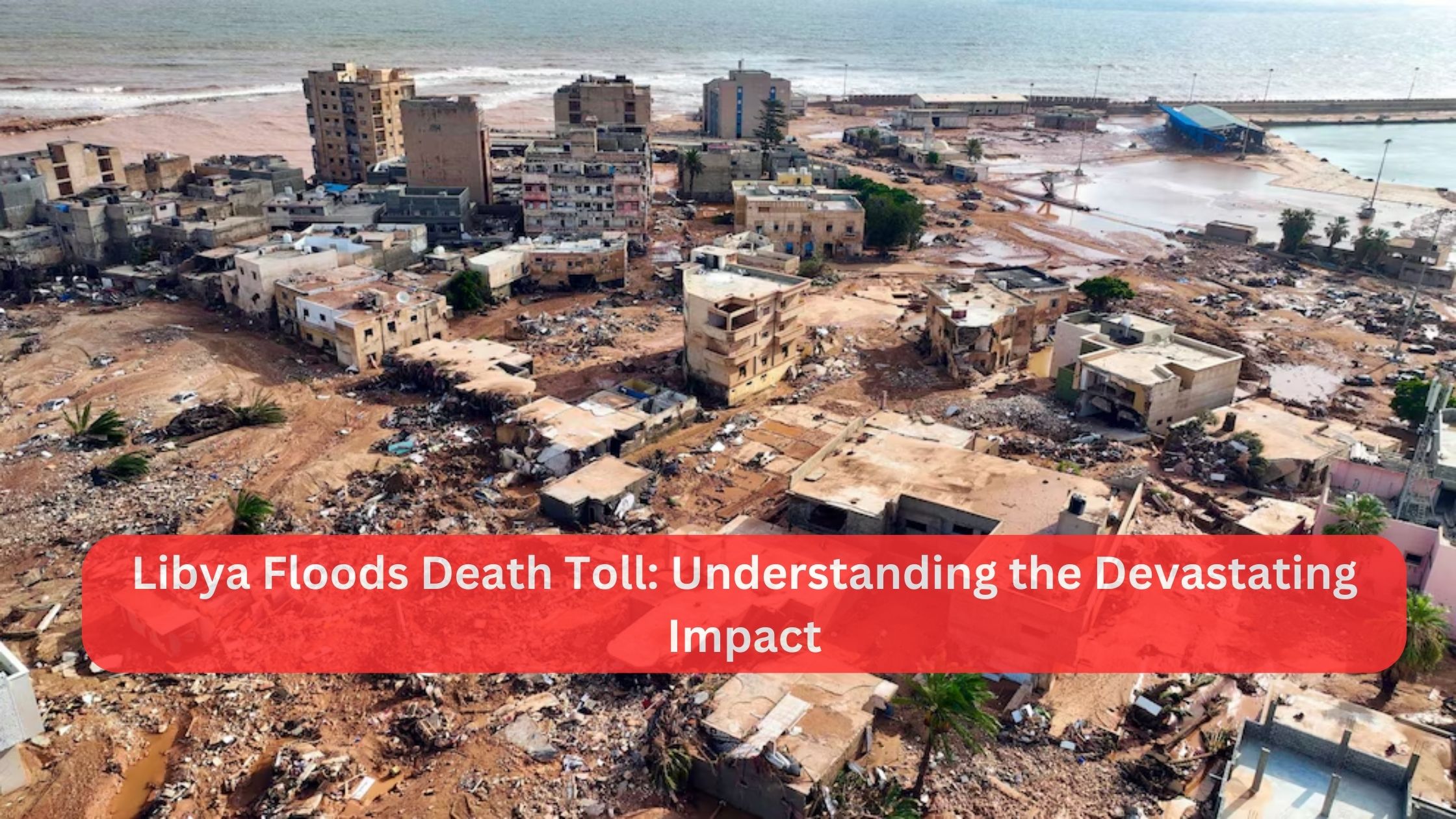Natural disasters have an unparalleled capacity to wreak havoc on communities, and when they strike, the consequences are often catastrophic. In recent years, the world has witnessed several devastating natural events, but one of the most tragic has been the flooding in Libya.
The phrase “Libya floods death toll” has become a stark reminder of the vulnerability of human life when faced with nature’s fury.
As of now, the death toll from the floods in Libya has surpassed 11,300, and the numbers continue to rise as rescue operations continue.
This article delves into the tragic events in Libya, exploring the causes, consequences, and the broader implications of such a disaster.
Chapter 1: Overview of the Libya Floods
1.1 The Geographic and Climatic Context
Libya, located in North Africa, is predominantly a desert country, with the Sahara covering most of its land. However, the eastern region of Libya, particularly the coastal areas, experiences a Mediterranean climate. This region, known as Cyrenaica, is where the catastrophic floods occurred.
The floods were triggered by a rare weather event that led to an unprecedented amount of rainfall, overwhelming the infrastructure and communities in the area.
1.2 Timeline of the Disaster
The floods in Libya occurred in early September 2023, following several days of heavy rain. The worst-hit areas included the cities of Derna, Benghazi, and Al Bayda. Torrential downpours caused rivers to overflow, dams to break, and a series of flash floods to sweep through the region. The floods not only destroyed homes and infrastructure but also claimed thousands of lives, with many people still missing.
1.3 Initial Response and Rescue Efforts
In the immediate aftermath of the floods, the Libyan government, along with international aid organizations, launched rescue operations. However, the scale of the disaster overwhelmed the available resources.
With roads washed away and communication lines down, reaching the affected areas proved to be a significant challenge. Despite these obstacles, rescue teams, including volunteers and international aid workers, continued to search for survivors and provide relief to those in need.
Also Read: Understanding the 333 Angel Number Meaning
Chapter 2: The Human Toll – Libya Floods Death Toll
2.1 The Rising Death Toll
As the waters receded and rescue teams gained access to previously unreachable areas, the true extent of the disaster became apparent.
The “Libya floods death toll” quickly became a harrowing statistic, with the number of confirmed deaths climbing steadily. Initially, the death toll was estimated to be in the hundreds, but as more bodies were recovered, the figure skyrocketed. By mid-September, the death toll had surpassed 11,300, making it one of the deadliest floods in recent history.
2.2 The Missing and the Displaced
In addition to the confirmed deaths, thousands of people remain missing. The floods swept away entire families, leaving many to wonder about the fate of their loved ones.
The number of displaced individuals is also staggering, with tens of thousands forced to flee their homes. Many of these displaced persons are now living in temporary shelters, uncertain of what the future holds.
2.3 The Impact on Families and Communities
The human impact of the floods extends beyond the death toll. Families have been torn apart, with parents losing children, and siblings separated.
The psychological trauma experienced by survivors is immense, and the process of grieving and rebuilding will take years. Communities that once thrived along the eastern coast of Libya are now faced with the daunting task of reconstruction, both physically and emotionally.
Chapter 3: Causes of the Flooding
3.1 Unprecedented Rainfall and Weather Patterns
The primary cause of the flooding in Libya was an unusual weather event that brought an unprecedented amount of rainfall to the region. While Libya is no stranger to heavy rain, the intensity and duration of the September 2023 storm were unlike anything seen in recent memory.
Meteorologists have pointed to a combination of factors, including climate change, as contributing to the severity of the storm.
3.2 Infrastructure Failures
Another critical factor that contributed to the disaster was the failure of infrastructure. The dams and levees in the affected areas were not designed to withstand such extreme weather conditions.
When the dams broke, the resulting deluge of water caused widespread destruction. The inadequacy of the region’s infrastructure has raised questions about the role of government oversight and the need for better preparedness in the face of climate change.
3.3 Environmental Degradation
Environmental degradation, including deforestation and poor land management, also played a role in exacerbating the floods. The removal of vegetation in certain areas reduced the land’s ability to absorb rainwater, leading to faster runoff and more severe flooding.
This aspect of the disaster highlights the interconnectedness of human activity and natural events, underscoring the importance of sustainable environmental practices.
Read More: Dollar tree family dollar stores closing: Analysis!
Chapter 4: The Broader Implications of the Libya Floods
4.1 The Role of Climate Change
The Libya floods are part of a broader pattern of increasingly severe weather events linked to climate change. As global temperatures rise, the frequency and intensity of storms are expected to increase.
The flooding in Libya serves as a stark reminder of the urgent need to address climate change on a global scale. Without concerted efforts to reduce greenhouse gas emissions and adapt to changing weather patterns, such disasters are likely to become more common.
4.2 The Need for Better Disaster Preparedness
The tragedy in Libya has exposed significant gaps in disaster preparedness and response. The failure of infrastructure, the lack of early warning systems, and the slow response to the floods all point to the need for better planning and coordination.
Governments and international organizations must invest in disaster risk reduction strategies, including the development of resilient infrastructure and the implementation of effective early warning systems.
4.3 Humanitarian Response and Global Solidarity
In the wake of the Libya floods, the international community has rallied to provide humanitarian assistance. Aid organizations have delivered food, water, medical supplies, and other essential items to those affected.
However, the scale of the disaster has highlighted the limitations of the current humanitarian system. There is a need for greater global solidarity and a more coordinated response to such crises, particularly as climate-related disasters become more frequent.
Read More: CDK Cyber Attack Update: A Comprehensive Guide
Chapter 5: Personal Stories and Survivor Accounts
5.1 Voices from the Ground
To truly understand the impact of the Libya floods, it is essential to listen to the voices of those who lived through the disaster. Survivors’ stories provide a human face to the statistics and help us grasp the depth of the tragedy.
Many survivors recount the terror of watching the floodwaters rise, the desperation of trying to save loved ones, and the grief of losing everything they once knew.
5.2 Stories of Heroism and Resilience
Amid the devastation, there have also been stories of heroism and resilience. Ordinary people risked their lives to save others, pulling neighbors from the floodwaters and providing shelter to the displaced. These acts of bravery and compassion are a testament to the strength of the human spirit in the face of unimaginable adversity.
5.3 The Long Road to Recovery
For the survivors of the Libya floods, the road to recovery will be long and difficult. Rebuilding homes, restoring infrastructure, and healing from the psychological trauma will take time and resources. The resilience of the Libyan people will be crucial in this process, but they will need support from the international community to fully recover.
Chapter 6: Lessons Learned and the Way Forward
6.1 Lessons for Libya and the World
The Libya floods offer several important lessons for both Libya and the global community. The disaster underscores the need for better infrastructure, more effective disaster preparedness, and a stronger focus on climate change mitigation. It also highlights the importance of international cooperation in responding to natural disasters.
6.2 Policy Recommendations
In light of the Libya floods, policymakers must take several key actions to prevent similar tragedies in the future. These include investing in resilient infrastructure, improving early warning systems, and implementing sustainable environmental practices.
Additionally, there must be a renewed focus on addressing the root causes of climate change, including reducing greenhouse gas emissions and transitioning to renewable energy sources.
6.3 The Role of the International Community
The international community has a critical role to play in supporting Libya’s recovery and preventing future disasters.
This includes providing financial assistance, technical expertise, and humanitarian aid. It also means working together to address global challenges like climate change and environmental degradation, which contribute to the increasing frequency and severity of natural disasters.
Also Read: United Airlines Passengers Sick: What You Need to Know
Chapter 7: Frequently Asked Questions (FAQs)
Q1: What caused the floods in Libya?
The floods in Libya were primarily caused by an unprecedented weather event that brought heavy rainfall to the region. The failure of dams and infrastructure, combined with environmental degradation, exacerbated the situation, leading to widespread flooding.
Q2: How many people died in the Libya floods?
As of the latest reports, the death toll from the Libya floods has surpassed 11,300. However, the number may continue to rise as rescue operations and recovery efforts progress.
Q3: What is being done to help the survivors of the Libya floods?
The Libyan government, along with international aid organizations, is providing humanitarian assistance to the survivors. This includes food, water, medical supplies, and temporary shelter. Rescue operations are ongoing, and efforts are being made to rebuild the affected areas.
Q4: How can I help the victims of the Libya floods?
You can help the victims of the Libya floods by donating to reputable aid organizations working in the region. These organizations are providing essential supplies and services to those affected by the disaster.
Q5: What are the long-term implications of the Libya floods?
The long-term implications of the Libya floods include the need for better disaster preparedness, resilient infrastructure, and a stronger focus on climate change mitigation. The disaster also highlights the importance of international
Conclusion
The devastating floods in Libya have left an indelible mark on the nation and the world. The staggering death toll, the destruction of homes and infrastructure, and the immense human suffering all serve as a tragic reminder of the power of nature and the vulnerability of human life.
The phrase “Libya floods death toll” is not just a statistic; it represents thousands of lives lost and countless families forever changed.



